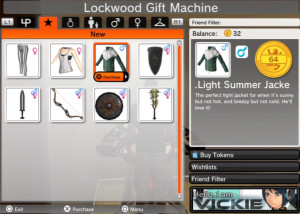The Gift Machine: Lockwood’s Clever Business Model Shift
by Terra_Cide, HSM Editor-in-Chief
There is, quite simply, a mind-boggling quantity of things available for purchase in Home. True, there are places like AlphaZone4, where, thanks to a dedicated team, you can look up all available items across all regions, but even Cubehouse, its founder, has admitted he can’t even keep up with it all anymore.
While this ever-continuing expansion of what’s available is fantastic because it provides the consumer with a wide variety of choice – something the community has clamored for since the beginning – this does present a problem. How does a developer combat the Eiffel Tower effect of the weekly content updates has on sales and still manage to earn enough to pay the people who create these items?
It may sound like an easy enough thing to do, if you stand by the old argument that a collective amount of microtransactions, region-wide, from numerous accounts – both main and alternate – add up over time. However, here’s the rub: because there is so much to choice coming out on a weekly basis, and so many developers from which to choose from, on top of the fact that the user base of Home is largely at a plateau by now, the returns on that 99-cent item (or what have you) aren’t what they used to be.
For clarity’s sake, let’s break the issue down into maths. I’ll do my best not to make this into an accounting lecture, and to help with that, you can listen to this whilst reading. Or listen to it whilst playing Cutthroats – it works well there, too.
For this example, let’s create a fictional Home developer – call them Imaginary Games, or I-Games, for short – and let’s say that this organization consists of ten employees, including the owner of the company. Shocked at such a small number? You’d be surprised at just how many Home developers are smaller than even that. Not to mention, it’s a nice, round figure which will make the math easier to follow.
Let’s say the average wage for each person working at I-Games figures out to roughly $25 per hour. Some earn more, some less. Those in the know may consider this a rather low number, but gut instinct tells me that the majority of Home users probably earn (on average) just a bit more than half that amount per hour. So there is the need to keep numbers down to a relatable level for the Home consumer.
Now, if you’ve ever been on salary, you know for a fact that there is no such thing as just a forty-hour workweek. You typically work along the lines of a 45-50 hour workweek; probably even more. So forget about overtime – it ain’t happenin’ – and when you are working in field like development (which is generally considered a white-collar industry), this is the norm. You’ll still be paid that $1000 a week ($25 per hour x 40 hour workweek) wage, regardless if you’ve worked 39 or 59 hours.
So for ten people, salaried at $1000 a week figures out to (before taxes – like I said, I’m not going to bore you with an accounting lecture) $10,000 a week in total, figuring out annually $52,000 per person, or $520,000 collectively in wages.
That’s more than half a million dollars in wage expenses annually alone.
This doesn’t even begin to factor in other overhead expenses, like rent for office space, insurance or utilities and equipment expenses. Nor is it factoring in the percentage Sony makes off of each developer’s sales. It’s not even accounting for the cost of filing the paperwork required for each item a developer proposes to create for Home, or all the hours spent in debug and QA. This is probably why we’re seeing smaller – not bigger – developers entering into Home, and probably why the bigger developers presently in Home have branched out onto other platforms. It’s just good business sense to not proverbially have all your eggs in one basket.
Speaking of smaller developers, let’s take that ten-person organization and cut it down to half – five people. Still making that rough average of $25 per person, per hour, that figures out to be $260,000 a year total in wages. And the other overhead costs still haven’t changed. Even if it’s just a two-person organization, it’s still a six-figure wages expense – $104,000 – in total per year.
That’s one helluva lot of $1.99 virtual furniture and clothes to sell just to break even. If that doesn’t make you want to slap the grey matter out of the next person who complains about prices on Home, I don’t know what will.
And don’t think that the simple answer to this is to pay the developers lesser wages. As mentioned, that theoretical $25 per hour figure was deliberately low-balled, based upon the average entry-level annual salary of someone breaking into the industry. Those with experience – even with the recent rash of bigger developers going out of business – would probably laugh you out the door if you offered them that much.
This now concludes the math portion of this article. If it’s made your head spin, here’s some more Monty Python accountant-related hilarity to help with that:
Here’s the flaw with Home’s business model – single-serve consumption. This may work on items that fetch a higher ticket price, but with microtransactions, the profit margins are razor thin at best. Once an item is purchased by an account, that’s it. Unless it’s someone with multiple accounts, there are no repeat purchases. One way to counterbalance this is to keep producing virtual items in an almost assembly-line precision, week after week. That way, a developer stands a chance at breaking even on the overhead incurred of producing the item. Not making a profit – breaking even.
Like the gaming industry at-large, this “throwing-mud-on-the-wall” strategy is common in Home. Take into consideration the handful of successful items a developer has versus the overwhelming number of items that aren’t successful. Those few successful items have to make enough to not only cover their overhead, but to cover the losses from the other items as well. Is it an efficient business strategy? No, but no one can predict with 100% accuracy what items will be wildly popular and will produce successful sales. Anyone recall the neon green sneakers for men making the top ten list last summer? (Seriously, what was up with that?)
So what’s a developer to do to make creating items for Home worthwhile from a business standpoint?
You create a means to get people to buy a repeat consumable.
There are a few developers who have succeeded to a fair degree with this. Mass Media has their Green Ticket and Midways, Digital Leisure has its Casino and poker chips, and Hellfire’s Home Tycoon – with its gold coins – has been such a big success for them that they’ve recently announced that they’re working to introduce it into Japan. Surely though, the daddy of them all has to be Lockwood’s Gift Machine tokens. For the former three, their sales are dependent upon the Home users that generally flock to those venues, but not everyone is a poker player or an aspiring city planner. The Gift Machine has a much broader appeal, and therein lies its success.
 It’s not just the fact that Home users can buy tokens – repeatedly – and give gifts to friends that makes the Gift Machine successful. It’s the sales of the actual token bundles themselves. Most of you are already familiar with the process. Whether it’s the pack of 80 tokens or the pack of 6240, it doesn’t matter if the pack supplies you with more tokens than you need, you must have a sufficient amount of tokens to complete the transaction. Nor does it matter if you spend more on buying tokens to obtain the item(s) in question than you would have if you had purchased the item outright, Lockwood made a sale. And it’s rare that a person buys a token pack, uses the amount of tokens necessary for the particular item desired to be gifted, and never uses the tokens again. Eventually, they will have to buy more tokens in order to repeat the process.
It’s not just the fact that Home users can buy tokens – repeatedly – and give gifts to friends that makes the Gift Machine successful. It’s the sales of the actual token bundles themselves. Most of you are already familiar with the process. Whether it’s the pack of 80 tokens or the pack of 6240, it doesn’t matter if the pack supplies you with more tokens than you need, you must have a sufficient amount of tokens to complete the transaction. Nor does it matter if you spend more on buying tokens to obtain the item(s) in question than you would have if you had purchased the item outright, Lockwood made a sale. And it’s rare that a person buys a token pack, uses the amount of tokens necessary for the particular item desired to be gifted, and never uses the tokens again. Eventually, they will have to buy more tokens in order to repeat the process.
Much like the five dollar minimum required when adding funds to your PSN wallet via a debit or credit card, the concept of getting people to convert a lump sum of cash into a currency that can only be used for a specific purpose is a very clever move, from a financial point of view, and it’s one that Lockwood is really starting to take full advantage of. For example, one could gift the platinum engagement ring, which requires 256 tokens. This would require one of two options: either buy four of the smallest token packs (80) for $3.96 or for roughly a dollar and 160 tokens more, buy the 480 token pack. Using unit pricing, it’s plain to see which is the better value. Either way though, there will still be tokens left over.
Ever since they introduced the concept of gifting personal spaces starting with the Dream Yacht: Arctic Voyage back in December, Lockwood has been expanding both their promotion and variety of the items available in the Gift Machine. This is not to say that the smaller items, such as furniture ornaments and accessories, are going completely away, but they don’t seem to dominate its inventory like it used to. In their place are items once seen exclusively as part of Lockwood’s weekly store updates. Instead selling an item and all its color and style variations for dollars and cents, they are reserving more and more for the Gift Machine. The fact that that they can also remove available items – and have done so – also increases the perceived exclusivity of items, which is a far better strategy than simply asking a large sum of money. That alone poses a strong argument for Lockwood to begin to merchandise the majority of their items exclusively through the Gift Machine.
 The counterargument to this is of course that not everyone has friends willing or able to send gifts. According to the data we collected from our survey, nearly a third of the people said they had an alternate account. It’s a high probability that a good portion of token sales are from people gifting themselves from one of those alternate accounts.
The counterargument to this is of course that not everyone has friends willing or able to send gifts. According to the data we collected from our survey, nearly a third of the people said they had an alternate account. It’s a high probability that a good portion of token sales are from people gifting themselves from one of those alternate accounts.
Why would Lockwood go through the effort of shifting their sales priority to tokens instead of out-and-out sales? As mentioned earlier, getting people to commit a lump sum of money into an exclusive currency is a very successful model. Even if a person never does a single Gift Machine transaction after their very first, Lockwood has made their money. The other reason is just speculation, but I’m willing to bet that the process for submitting items for retail through the Gift Machine is far more streamlined than it is via the store. It’s probably even more streamlined when there is at least one variation of an item available for traditional sale.
With the ability to secure a lump sum of money for people’s consumption and to cater to people’s psychological need to give their friends gifts (and, to a lesser extent, to have something others might not), the Lockwood Gift Machine is as close as it gets to a “killer app” for Home. While other developers have come close with similar ventures, none are as nearly all-encompassing. And this latest shift by Lockwood to bring it more to the forefront of their sales ventures in the current climate of overwhelming purchase options is arguably their most clever to date.
Share
| Tweet |




 Twitter
Twitter
I got stuck at the $25 being a “very low hourly wage” bit while reading this. Really!? I’ve been self-employed for a long time now -- too long to know what the UK’s minimum wage is, but I’d take an educated guess at about £6 an hour. But hey, whadda I know about US wages…
As for the business model of getting people to turn their actual monies into Disney points, Monopoly money, LKWD Tokens or whatever, I say fair play to them, coz it definitely works wonders.
Personally, when I’m presented with this option I tend to see it as a bag going over my head an’ the baseball bats coming out. But I guess sometimes we just dont get any other options and have to buy into it if it’s something we really really want.
“Very low wage” in the gaming industry. Trying to compare it to other industries would be apples to oranges. When I did the research for this article, I looked for the average wage, industry-wide, both for those who have been working in videogames for a few years and those who are in entry-level positions. What was given was the annual salary, so I had to work the math backwards based on a forty hour work week (which we all know is a farce in the real world, but anyways…).